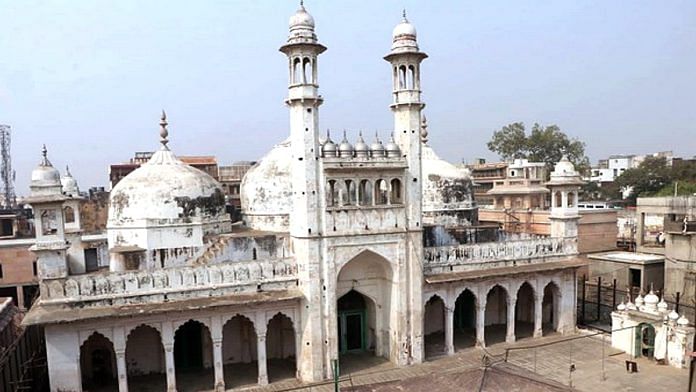New Delhi: The Allahabad High Court Monday called the 1993 UP government action of stopping the Vyas family and other devotees from worshipping in the ‘Vyas tehkhana’ (southern cellar) of the Gyanvapi mosque “illegal”.
The statement came while the HC rejected appeals filed by the mosque management committee against two orders passed by the Varanasi district court in January to pave the way for Hindus to worship in the cellar. The district court order had come after Shailendra Kumar Pathak ‘Vyas’ filed a legal suit, claiming the state government stopped his family from worshipping in the mosque’s cellar in 1993.
“Article 25 of the Constitution of India grants freedom of religion. The Vyas family, who continued to perform religious worship and rituals in the cellar, could not be denied access by oral order. A citizen’s right guaranteed under Article 25 cannot be taken away by arbitrary action of the State,” Justice Rohit Ranjan Agarwal said Monday, while quashing the appeals.
The state government restricted the Vyas family from entering the mosque’s cellar a year after the 1992 Babri mosque demolition when Mulayam Singh Yadav was at the helm of affairs in UP. The HC pointed out that the state government did not issue “any order in writing” for the same.
The court opined that prima facie, “the act of the state government since year 1993 restraining Vyas family from performing religious worship and rituals and also by the devotees was a continuous wrong being perpetuated”.
According to the mosque management committee, the Vyas family never worshipped in the cellar, which, it said, has no image of Hindu deities. The HC, however, said the mosque management committee could not establish prima facie possession of the premises when it was iron-fenced and barricaded in 1993 after the 1992 Babri mosque demolition.
“Stopping worship and performance of rituals by the devotees in the cellar would be against their (the mosque management committee’s) interest,” it added.
The Committee of Management, Anjuman Intezamia Masajid, Varanasi, had approached the HC against two district court orders — a 17 January order appointing the district magistrate as the cellar’s receiver and a 31 January order asking the DM to arrange for worship in the cellar.
Shailendra Kumar Pathak ‘Vyas’ filed the legal suit last year before a civil judge in Varanasi against the mosque management committee and the board of trustees of the Kashi Vishwanath Temple. Pathak said he is entitled to perform all rituals in the cellar and demanded restraint on the respondents from creating obstacles.
Pathak also claimed to be the hereditary pujari of Sri Vyaspeeth, situated within the mosque premises. He submitted that the cellar in the southern side of the mosque is the “principal seat of hereditary pujari of Vyas family…from time immemorial”.
In December 1993, the then DM had instructed the then-pujari Sri Somnath Vyas to stay away from the mosque’s cellar.
Also read: Supreme Court turns down Gyanvapi committee’s plea against prayers by Hindus in mosque’s basement
‘Violates Article 25 rights’
Pathak’s suit brought the 1993 decision of the state government and the district administration to restrict the family from entering the cellar under the scanner. The move, Pathak said, violated his fundamental rights under Article 25 of the Constitution.
The suit also referred to the mosque as the temple of Lord Adi Visheshwar, submitting that a ‘farman’ issued by Aurangzeb in 1669 caused substantial damage to the temple complex. After that, the Gyanvapi mosque came up at the site.
In response to the suit, the mosque management committee had rubbished the claims, saying there was no image of any god or goddess in the cellar and the Vyas family never used it for prayers.
In October last year, the suit was transferred from the civil court to the district judge.
On 17 January, the judge appointed the district magistrate as the cellar’s receiver, who would take the property in his custody and control and preserve it during the pendency of the suit.
On 31 January, the court directed the district magistrate to make arrangements for worship and asked Pathak and the Kashi Vishwanath Trust Board to help appoint the priest.
Map filed by government
The Allahabad High Court has now upheld both the district court orders.
The mosque committee had relied on a suit filed by Din Mohammad in 1936, with a civil judge ruling in August 1937 that the property in dispute was declared a mosque.
However, the HC noted that a map filed by the state government as part of the suit described the cellar in dispute as the “tehkhana owned by Vyas ji”.
The HC said that prima facie, Pathak established his possession of the cellar from 1551 through the Vyas family. The map “is conclusive proof of the cellar owned and in possession of Vyas family in 1937”.
About the appointment of a receiver, the court observed, “He is appointed for the benefit of all and is a representative of the Court and all the parties interested in litigation.”
(Edited by Madhurita Goswami)



